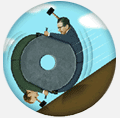


Reinvent or die. Business magazines (including this one) are full of such axioms. But they contain a measure of truth. The challenge of continually reinventing your company to survive in a business environment where change comes faster than ever is real and formidable. It means implementing repeated, sustainable change to achieve profitable growth in a fiercely competitive global marketplace.
Former Honeywell CEO Larry Bossidy has championed superior execution as the hallmark of business leadership. But superb execution of a strategy that achieves only incremental gains is no longer the answer. Nor are most mergers and acquisitions. In fact, preoccupation with M&A integration inhibits companies from focusing on innovation. Witness the AOL Time Warner debacle.
Relatively few companies—notably Dell, Wal-Mart, Southwest Airlines, Home Depot, Starbucks and eBay—have completely reinvented not just themselves but also their industries. Even fewer have been able to do so continuously to meet the realities of a rapidly changing business climate. But, the question remains, can these innovative powerhouses transform their sectors over and over and achieve even higher levels of growth?
To reach this lofty but imperative goal, a company must evaluate its culture, leadership, organizational capabilities, measurements and rewards systems, and methodology. Dell, Wal-Mart and Southwest, it seems safe to say, all retain a mindset for continuous reinvention, although they’re limited somewhat by their respective industries’ growth rates. It’s too early to tell with eBay and Starbucks, and Home Depot faces steep challenges in this regard.
Assessing their companies’ potential for continuous reinvention, CEOs also must consider three other factors: ultimate customer experience, unique business model and breakthrough innovation capability. In terms of customer experience, Dell and eBay clearly score the highest, while Wal-Mart and Home Depot face significant hurdles. As for business model, Dell, eBay and Southwest have the edge, while Wal-Mart and particularly Home Depot are losing the advantage of uniqueness; Starbucks can easily be challenged. All of them can and must improve their continuous breakthrough innovation capability.
Unlike reactive companies focused on incremental growth, so-called “built to reinvent” companies plan and implement a broad range of simultaneous, game-changing moves designed to achieve hypergrowth. How do they accomplish this? First, they develop, select and execute a series of highest-impact, game-changing ideas. The goal is to gather hundreds of these innovative ideas by leveraging the creativity of an entire organization and its network. To drive the process, my firm uses more than 50 strategic-thinking techniques, which I first formulated during my 14 years at General Electric working with Jack Welch. Using a market-driven validation and prioritization process, we winnow down ideas to the ones with the highest potential impact. The key is to engage the visionary and strategic thinking of customers in interactive sessions. Properly executed, these ideas are the dynamo that will drive the company’s reinvention.
The transformation of Siemens Medical, a unit of Siemens, is a case in point. A leading provider of medical imaging equipment, Siemens Medical traditionally sold its product almost exclusively to hospitals. Employing continuous reinvention techniques, Siemens first questioned every business assumption the company ever made; redesigned and simplified its complex product line; lowered its equipment costs by 30 percent; and, for the first time, began to market new products to a broader universe of radiologists, oncologists and cardiologists in private practice as well as hospitals. Within six months, Siemens’ market share, which had fallen from 25 percent to 8 percent, rocketed to an industry-leading 40 percent. Rival Toshiba opted to outsource its products from Siemens.
Continuous reinvention is more than a glib catchphrase. It is the hard truth that can guide success in this new global business universe. To do otherwise is to stagnate, to fall behind and, ultimately, to die.
Jay Desai is founder and CEO of the Institute of Global Competitiveness, Cary, N.C.